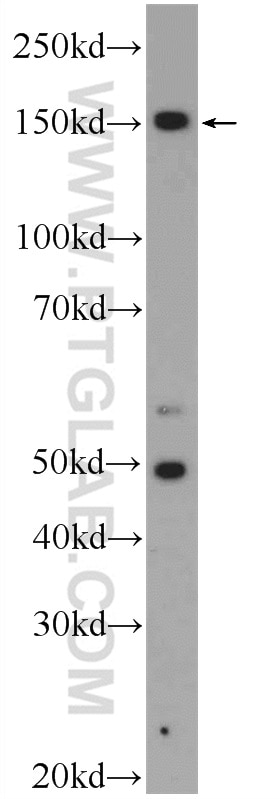Tested Applications
| Positive WB detected in | HEK-293 cells |
Recommended dilution
| Application | Dilution |
|---|---|
| Western Blot (WB) | WB : 1:500-1:1000 |
| It is recommended that this reagent should be titrated in each testing system to obtain optimal results. | |
| Sample-dependent, Check data in validation data gallery. | |
Published Applications
| KD/KO | See 10 publications below |
| WB | See 16 publications below |
Product Information
23111-1-AP targets ZRANB3 in WB, ELISA applications and shows reactivity with human samples.
| Tested Reactivity | human |
| Cited Reactivity | human |
| Host / Isotype | Rabbit / IgG |
| Class | Polyclonal |
| Type | Antibody |
| Immunogen |
CatNo: Ag19407 Product name: Recombinant human ZRANB3 protein Source: e coli.-derived, PET28a Tag: 6*His Domain: 728-1079 aa of BC064616 Sequence: LPVYDTLMFCASRNTDRIHIYTKDGKQMSCNFIPLDIKLDLWEDLPASFQLKQYRSLILRFVREWSSLTAMKQRIIRKSGQLFCSPILALEEITKQQTKQNCTKRYITKEDVAVASMDKVKNVGGHVRLITKESRPRDPFTKKLLEDGACVPFLNPYTVQADLTVKPSTSKGYLQAVDNEGNPLCLRCQQPTCQTKQACKANSWDSRFCSLKCQEEFWIRSNNSYLRAKVFETEHGVCQLCNVNAQELFLRLRDAPKSQRKNLLYATWTSKLPLEQLNEMIRNPGEGHFWQVDHIKPVYGGGGQCSLDNLQTLCTVCHKERTARQAKERSQVRRQSLASKHGSDITRFLVKK Predict reactive species |
| Full Name | zinc finger, RAN-binding domain containing 3 |
| Calculated Molecular Weight | 1079 aa, 123 kDa |
| Observed Molecular Weight | 150 kDa |
| GenBank Accession Number | BC064616 |
| Gene Symbol | ZRANB3 |
| Gene ID (NCBI) | 84083 |
| RRID | AB_2744527 |
| Conjugate | Unconjugated |
| Form | Liquid |
| Purification Method | Antigen affinity purification |
| UNIPROT ID | Q5FWF4 |
| Storage Buffer | PBS with 0.02% sodium azide and 50% glycerol, pH 7.3. |
| Storage Conditions | Store at -20°C. Stable for one year after shipment. Aliquoting is unnecessary for -20oC storage. 20ul sizes contain 0.1% BSA. |
Background Information
ZRANB3, also named Annealing helicase 2 or DNA annealing helicase and endonuclease ZRANB3, is a 1079 amino acid protein, which contains one RanBP2-type zinc finger, one helicase C-terminal domain, one HNH domain and one helicase ATP-binding domain. ZRANB3 localizes in the nucleus and belongs to the SNF2/RAD54 helicase family. ZRANB3 as a DNA annealing helicase and endonuclease is required to maintain genome stability at stalled or collapsed replication forks by facilitating fork restart and limiting inappropriate recombination that could occur during template switching events.
Protocols
| Product Specific Protocols | |
|---|---|
| WB protocol for ZRANB3 antibody 23111-1-AP | Download protocol |
| Standard Protocols | |
|---|---|
| Click here to view our Standard Protocols |
Publications
| Species | Application | Title |
|---|---|---|
Nat Commun Excessive reactive oxygen species induce transcription-dependent replication stress
| ||
Mol Cell Active DNA damage eviction by HLTF stimulates nucleotide excision repair.
| ||
Mol Cell Replication Fork Slowing and Reversal upon DNA Damage Require PCNA Polyubiquitination and ZRANB3 DNA Translocase Activity.
| ||
Mol Cell Fork Cleavage-Religation Cycle and Active Transcription Mediate Replication Restart after Fork Stalling at Co-transcriptional R-Loops.
| ||
Mol Cell CtIP-Mediated Fork Protection Synergizes with BRCA1 to Suppress Genomic Instability upon DNA Replication Stress.
| ||
Nat Commun Replication fork reversal triggers fork degradation in BRCA2-defective cells.
|




